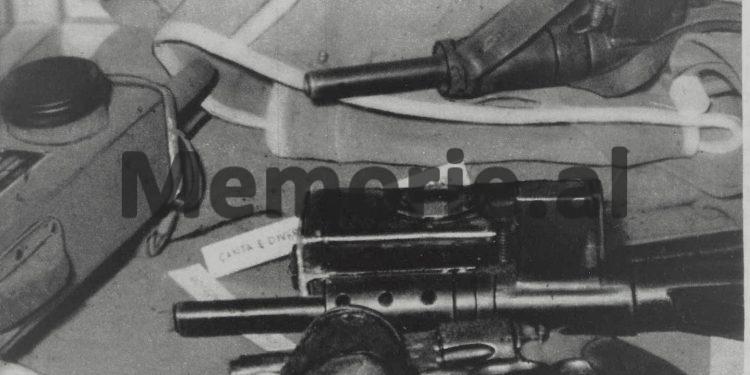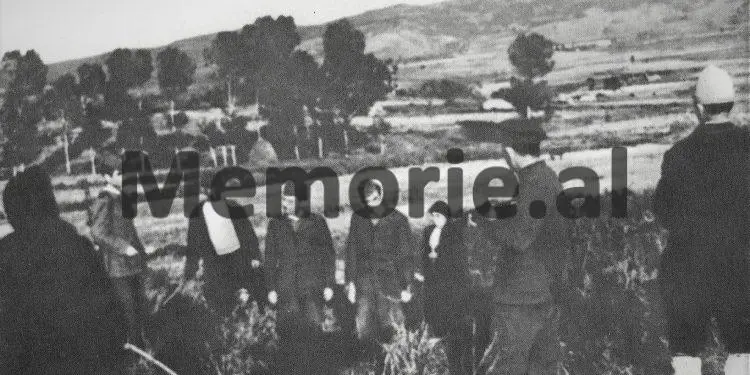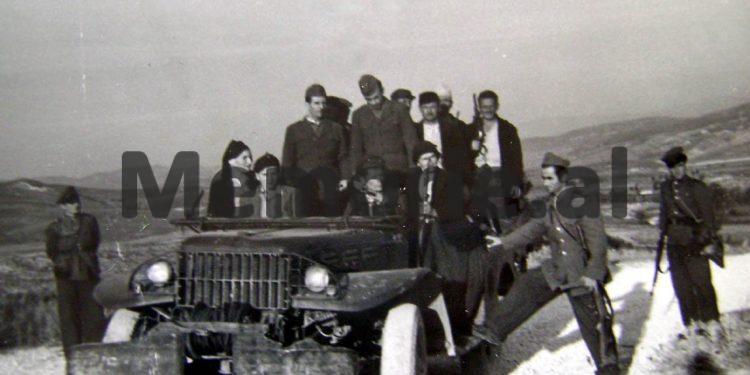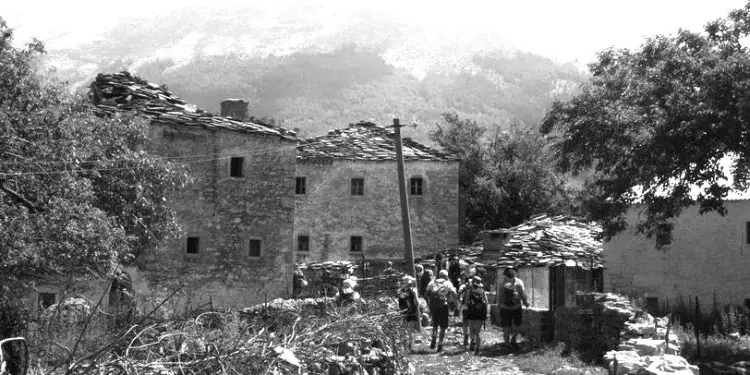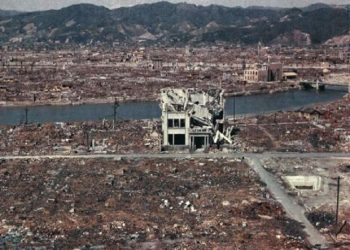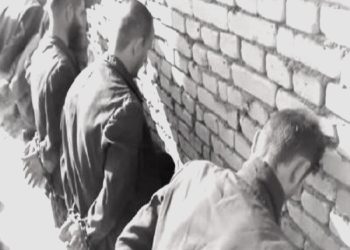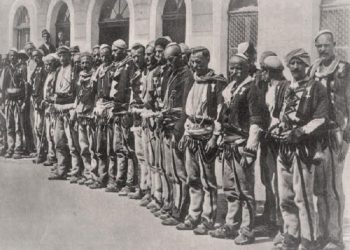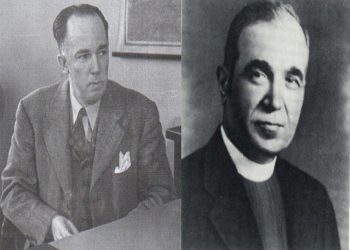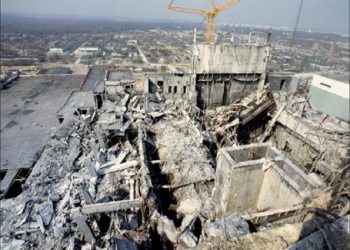From Luftar Pepmarku
Memorie.al / “I cannot leave without mentioning the tragic episode of my two close friends, Ibrahim Nezha and Osman Pepmarku, who, after the inhumane torture inflicted on them over the course of a year, forced them to dig a hole, thrown alive into it and then a metal carrier was thrown over them, with sharp metal pins, to be stuck in their bodies. They threw stones and soil on top of this vehicle, and thus left them to die”, writes Zef Margjini, among others, in his book of memories, bringing us an interesting and extremely shocking fact.
Halit Hajri with a formation was assigned to arrest Ibrahim Nezha and Sabri Gjongega in Gure-Lure. Banush Goxhaj, with another formation, Osman Pepmark and Ahmet Kurt Pepmark, in the village of Gjoçaj. Ramadan Gjoka, led the forces that would arrest Zef Margjin in Bozhiq (Bardhaj), while Gjolek Alia, would arrest Ahmet Sulë Pepmarku in the village of Zall-Gjoçaj.
Precisely in these days, the operation starts from the Internal Affairs Branch of Burrell. A real situation of terror had been created. The movements of the officers, their entrances and exits in the offices, meetings with the Security agents, whispers, separations and then contacts again, had created a real anxiety, since no one knew what was happening, although it was felt that something macabre was being prepared.
And who would have the turn to become a victim of this cruelty, which was manifested in the outraged faces of the Security employees? No one knew this. Preparations were being made as if armed airborne troops had landed in the area of Selita or Lura, and not as if to arrest 5-6 people, who had not committed any crime in their lives, apart from the fact that they were taking measures, to escape the bloody claws of the dictatorship. This spirit was created to justify their savagery. Tasks were divided.
The operation was led by Rexhep Kolli, a senior official of the Ministry of Internal Affairs, who had come specially from Tirana. Everything was organized so well that all the planned persons were arrested, with the exception of Zef Margjini. The arrested saw each other in Derjan, where the first collection point was also.
From there, they take away Osman Pepmark’s watch, which was of a very precious brand, as well as the kestek (string of serm), which he had as a gift from his friend, Zef Margjini, whom some miracle had saved this time, without fallen into the hands of the ferocious communist beast.
The investigations were initially carried out by lieutenant Gjolek Alia, but the Ministry of Internal Affairs, dissatisfied with the wording of the indictment, as, according to it, the predetermined punishments were not justified, dismissed the charges and appointed another group of investigators, headed by Garip Hall.
The indictment was signed by the deputy prosecutor of the garrison, Captain Hilmi Telegrafi, who also represented the indictment of the hearing, while the chairman of the jury was appointed Captain Mustafa Iljazi. On December 19, 1949, the Military Court handed down the following sentences:
1-Ibrahim Ahmet Nezha, “as the initiator of the creation of this group and repeater, (after he was sentenced once again for escaping from the army with 8 years in prison and was released by an amnesty of 1947) – is sentenced to death, by firing squad” .
2-Osman Sulejman Pepmarku, “as an active member of this group, where he not only propagated against the regime, but played a role in expanding the circle of members and sympathizers of this group – is sentenced to death, by firing squad”.
3-Ahmet Kurt Pepmarku, sentenced to 15 years in prison (later dies in prison).
4-Ahmet Sulë Pepmarku, sentenced to 20 years in prison.
5-Fali Dulle Zita, sentenced to 20 years in prison.
6-Sabri Gjongega, sentenced to 5 years in prison.
After this sentence, which was previously signed in the secretaries of the Ministry of Internal Affairs in Tirana, the convicts in general experienced countless inhumane tortures. Those who managed to get out of prison alive and later, when I had the chance to meet them, spoke to me in a special way about the macabre tortures that were practiced on the death row convicts, Ibrahim Nezha and Osman Pepmarku.
Thus, Ivzi Xhilaga from Dibra, Preng Arapi from the village of Zais i Mirdita, Selami Xhydollari from Pogradeci, Isuf Selmani from the village of Lis in the district of Mati, have told me about the excruciating tortures that the executioners have inflicted on the above-mentioned two. Even the nationalist Zef Margjini, in his book of memories, brings an interesting and very shocking fact.
Among other things, he writes: “I cannot fail to mention the tragic episode of my two close friends, Ibrahim Nezha and Osman Pepmarku, who, after the inhumane torture exercised against them for a year, forced them to dig a pit, they threw them alive into it and then they threw a metal carrier on top of them, with sharp metal pins to stick in their bodies. On top of this carrier they threw stones and earth, and so they left them to die.”
This is how the bloody massacre of the new government, whose name was Communism, had begun and was continuing. But executioners would not be enough in my province. “Eclipse” would be hundreds of times more tragic.
In addition to the murders of fighters from well-known nationalist doors, which we have mentioned at the beginning of this article, with dozens and dozens of other individuals who had distinguished themselves as brave fighters in the fight against the fascist invaders, communism not only closed its doors but persecuted them, imprisoned and killed their blood, exiled them to the concentration camps set up by the dictatorship itself especially for the families of the heroes, martyrs and brave men of Albania.
The hatred would reach so far that the red bloodsuckers would even deal with the towers of these mountaineers. Just as songs and ballads, narratives and stories, famous or ordinary people, glory or shame, towers have a place there, above the head of history.
Montenegrins, Serbs and Austrians were also engaged in burning towers. Even the Italians and the Germans had done the same thing. The strong towers had felt the cannons, the bombings of the planes, the flames, and the smoke, but every time those buildings and symbols of resistance were burned and collapsed, they rose again, stronger and more beautiful than the first ones. The poet of freedom, Ali Podrimja, writes somewhere: “…Because of love, / because of hatred, / my father built a tower…”.
And this very significant sentence, this philosophical-poetic message, has a great truth. The brave have always come out of the towers and songs of bravery and love have been created and sung there. Decisions were made there, popular leaders emerged from there, and history began there.
Communism went even further. The towers rebuilt for the umpteenth time by the nationalist family members of my province were torn down again, and later the foundation stones were removed, in order to completely eradicate the “infection” of nationalism and, in its place, introduce their ruins, the new seed of communism! With this, he intended to perform the iron rite of subjugation and the establishment of a new slavery. Thus, for some time, the dictatorship used these towers for its own needs.
The tower of Menajve in Lure was used as a hostel for stockists, where the famous writer, Ismail Kadare, spent a night among the students of the University of Tirana. Later, they completely destroyed the tower, taking the stones to build a culture house. They did the same thing with Kulla e Kolajje, in Macukull, which for several years they used as a school, and later they destroyed it from the foundations, and built a new school with its stones.
The same fate would be suffered by the tower of the author of these notes, which, after being used for several years to shelter a family in need, later destroyed it too, under the pretext that with its stones, they would build a water supply. for the village. As if there were no stones in those matches! How many towers, not only in my province, but in all of Albania, succumbed to this tragic fate?!
They were also killed without trial:
Haziz Kasemi, Tahir Mata, Xhemal Sala,
Haziz Suçi, etc. They would take the escape route: Gjon Mëhilli
Zef Margjini, Llesh Nikoll Lleshi, Sadik Skura, Shahin Koleci,
Ibrahim Gjokola, as well as many other sons of my province, whose lives were threatened by the communist plague. Later they died away from their families’ homeland, in exile.
What did these honest and patriotic people do to experience this terrible ordeal of suffering and miseries?! The only “guilt” of these people was the fact of being nationalist and anti-communist.
That was enough for the communist cynicism to take out its teeth to eliminate this layer, to escape from a “great evil”. Communism had begun to fight Albanian traditions and customs. The collectivization of agriculture, the herding of peasant cattle, would gradually become a reality.
A fierce war would be waged against religious beliefs. Their institutions, such as churches, mosques and mosques, would also be damaged and destroyed.
Thus, as in the whole of Albania, in my province too, the savage communist terror had a long and difficult life. For half a century, the highlanders of these three experienced the dictatorship as an eclipse of their lives and dreams. Like a true barbarian…! Memorie.al




